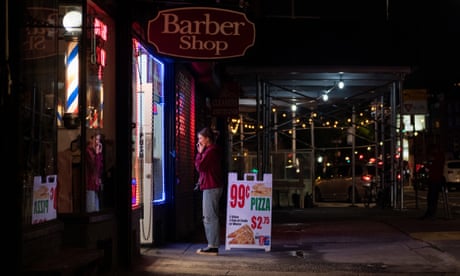- by foxnews
- 23 May 2025
Slice of life: New York?s famed $1 street pizza under threat from rising costs
Slice of life: New York’s famed $1 street pizza under threat from rising costs
- by theguardian
- 26 Dec 2021
- in news

"Well, you can never go wrong with bread, cheese and tomato," Lou Reed, poet of the New York streets, would sometimes remark as he passed by one of the city's multitude of pizzerias.
The late musician was a fan of Coney Island's legendary Totonno's, close to the site of of one of the first recorded pizza parlors established by Italian immigrants in the 1880s.
One hundred and forty years on, New York's obsessive relationship with cheap street pizza - there are around 1,700 pizzerias across the city - is as enmeshed as ever. But there are now cracks in that union. Rent is increasing, and supply chain problems leading to inflation is pushing up the cost of oil, cheese, wheat and meat. Deliveries are spotty, tomato sauce faces higher shipping costs, and pizza boxes are scarce.
Now the existence of the fabled 99¢ or dollar pizza outlets that rely on fast, high-volume trade is being threatened after nearly two years of pandemic-reduced foot traffic. That is a blow not only to the city's image, but also to many low-income New Yorkers in times of trouble.
Abdul Muhammad, owner of 99 Cent Fresh Pizza, an eight-location chain in Manhattan, said he may raise the price of his slice for the first time since opening in 2001 if costs continue to rise. "I have to think about it because my customers, many of them unemployed and struggling to make rent, can't afford to pay more."
99 Cent Fresh stayed open during the pandemic except for one month in March 2020, in part, Muhammed said, because he knows that for some of his customers a slice is all the food they may get.
"I feel bad because everybody has had a lot of problems with the coronavirus, no jobs, everything was closed, and the food stores that were open doubled their prices. So I try to stay open to help the people," Muhammad added.
Outside the 99 Cent Fresh location on 6th Avenue and 8th street, several customers said they relied on the outlet. "I come here when I'm hungry, but I can't come here all the time because I'm diabetic," said Sam Pegano, who said he was homeless. "It's important to me, especially in the winter, because it's hot food."
Others stopping by said the dollar slice was important to their lives because it was fast and cheap.
"People in New York love dollar-slice pizza because they're everywhere around the city and they're open late," said NYU data science graduate Bishank Gaglani. "Whenever you need to grab a bite, and don't know what to have, you can have a slice and you're good to go."
Gaglani said he'd noticed that prices had been rising. "I cant imagine New York City without the dollar slice. But even if it goes to $1.50, people will still come."
Within New York's complex pizza ecology, the 99¢ or dollar slice has a controversial reputation. Pizzerias like the famous John's of Bleecker Street won't touch the slice trade, opting only for complete pies. Others embellish their slices, and jacked up prices to $4 of more.
The search of the perfect pizza, a quixotic undertaking, occupies some minds, including that of Scott Weiner, owner of Scott's Pizza Tours, which ferries enthusiasts across the city by bus in that search.
According to Weiner, the dollar-slice business model emerged as a business that worked next to homeless shelters. "It almost seemed like a public service," he said. After the 2008 recession, the business expanded to high foot-traffic areas and transportation hubs.
"It became late-night food for drunk people with the same economics as a $3 slice shop but with more volume," he said. "At the same time, it lowered the perception of quality of pizza in New York, and became a shining beacon in a city that's so expensive to live. It was like, look at how cool this city is - you can get a slice of pizza for a dollar."
While New Yorkers are forced to pick and choose their battles - high rents being common - the cheap pizza slice is a way to, in a sense, win one back. "The citizenry is empowered by the variety of pizza in New York because you can choose between getting an 12in, high-quality, great-ingredients, skilled-producer single-serving Neapolitan pizza for $18 or the dollar-per-slice at the opposite end of the spectrum," said Weiner.
Both, Weiner said, can quench the thirst - "it just depends on what the thirst is".
At the same, Weiner worries that dollar-slice chain owners have committed themselves to their pricing in their name and cannot withstand pricing fluctuations. When leases are renewed with higher rents, that alone can wreck New York's famously tough restaurant business model - which has been hit hard by the pandemic. By some estimates, more than 1,000 New York restaurants have closed during Covid-19.
But - despite current travails - New York's pizza love affair is set to continue. After all, it has such a long past.
Pizza historian Peter Regas traces the first published accounts of a pizzeria to Naples around 1845, when it was described as the "gastronomic thermometer of the market". By the end of the century, Italian immigrants had bought the tradition to New York and established pizza ovens, often in taverns, in harbor or beachfront neighborhoods like Red Hook and Coney Island.
"It's pretty definitive that New York is the home of the pizza in America," Regas said.
The industry grew after the lifting of prohibition in the 1930s, the Great Depression and further after the second world war, spreading to Chicago. Regional differences began to develop. Chicago, home of the deep-crust pizza, has scant tradition of slice culture.
The custom of the single slice, which came into being in the late 1940s, is integral to New York, despite the misgivings of more traditional pizzeria owners, said Regas. The loss of it, he believes, would be a loss to all.
Regas recalled a legendary pizzeria Di Fara on Avenue J in Brooklyn.
The elderly owner, Dom, who had been operating there since 1964, became known as the guy for a slice. "I went there in 2006 and there were like 50 people in his shop just staring at him," he said.
"There's a magic to pizza. There's an individual personality to a pizza that you don't necessary get with a hamburger or hot dog, and that plays into the mystery and drama of the whole thing."
- by foxnews
- descember 09, 2016
United Airlines flight returns to Hawaii after concerning message found on bathroom mirror; FBI investigating
United Airlines Flight 1169 to Los Angeles returned to Hawaii after a "potential security concern" aboard the plane. The FBI and police are investigating.
read more


